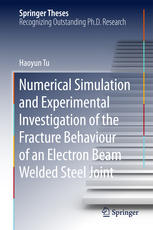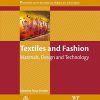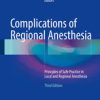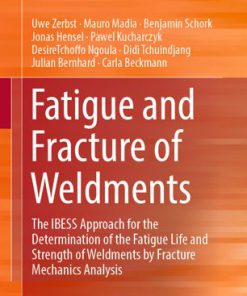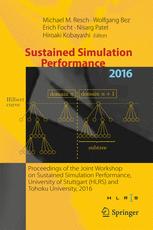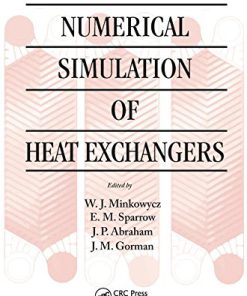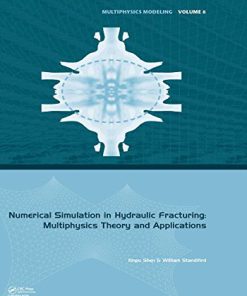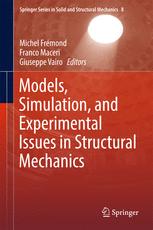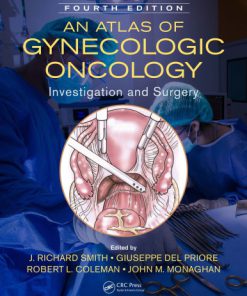Numerical Simulation and Experimental Investigation of the Fracture Behaviour of an Electron Beam Welded Steel Joint 1st Edition by Haoyun Tu ISBN 3319672770 9783319672779
$50.00 Original price was: $50.00.$25.00Current price is: $25.00.
Numerical Simulation and Experimental Investigation of the Fracture Behaviour of an Electron Beam Welded Steel Joint 1st Edition by Haoyun Tu – Ebook PDF Instant Download/Delivery: 3319672770, 9783319672779
Full download Numerical Simulation and Experimental Investigation of the Fracture Behaviour of an Electron Beam Welded Steel Joint 1st Edition after payment
Product details:
ISBN 10: 3319672770
ISBN 13: 9783319672779
Author: Haoyun Tu
In this thesis, the author investigates experimentally and numerically the fracture behavior of an electron beam welded joint made from two butt S355 plates. The 2D Rousselier model, the Gurson-Tvergaard- Needleman (GTN) model and the cohesive zone model (CZM) were adopted to predict the crack propagation of thick compact tension (CT) specimens. Advantages and disadvantages of the three mentioned models are discussed. The cohesive zone model is suggested as it is easy to use for scientists & engineers because the CZM has less model parameters and can be used to simulate arbitrary crack propagation. The results shown in this thesis help to evaluate the fracture behavior of a metallic material. A 3D optical deformation measurement system (ARAMIS) andthe synchrotron radiation-computed laminography (SRCL) technique reveal for the first time the damage evolution on the surface of the sample and inside a thin sheet specimen obtained from steel S355. Damage evolution by void initiation, growth and coalescence are visualized in 2D and 3D laminographic images. Two fracture types, i.e., a flat crack propagation originated from void initiation, growth and coalescence and a shear coalescence mechanism are visualized in 2D and 3D images of laminographic data, showing the complexity of real fracture. In the dissertation, the 3D Rousselier model is applied for the first time successfully to predict different microcrack shapes before shear cracks arise by defining the finite elements in front of the initial notch with inhomogeneous f0-values. The influence of the distribution of inclusions on the fracture shape is also discussed. For the analyzed material, a homogeneous distribution of particles in the material provides the highest resistance to fracture.
Numerical Simulation and Experimental Investigation of the Fracture Behaviour of an Electron Beam Welded Steel Joint 1st Table of contents:
1 Introduction
1.1 Motivation
1.2 Outline
2 Scientific Background
2.1 Electron Beam Welding
2.2 Fracture Mechanics
2.2.1 The Fracture Mechanics Approach
2.2.2 The Brittle Fracture
2.2.3 The J-Integral
2.3 Constitutive Damage Models
2.3.1 The Rice and Tracey Model
2.3.2 The Rousselier Model
2.3.3 The Gurson-Tvergaard-Needleman (GTN) Model
2.4 Cohesive Zone Model (CZM)
2.5 ARAMIS System
2.6 Synchrotron Radiation-Computed Laminography (SRCL)
References
3 Characterization of Steel S355 Electron Beam Welded (EBW) Joints
3.1 Chemical Composition
3.2 Microstructures of Steel S355 EBW Joints
3.3 Mechanical Properties of S355 EBW
3.3.1 Hardness Measurement
3.3.2 Tensile Behaviour of Different Tensile Specimens
3.3.3 Fracture Surface of Notched Specimens
3.4 Fracture Behaviour of S355 EBW Joints
3.4.1 Fracture Toughness Tests
3.4.2 Fracture Surface Analysis of C(T)-Specimens
3.5 Summary and Conclusions
References
4 The Rousselier Model
4.1 Parameter Study Using the Rousselier Model
4.1.1 Influence of {hbox{f}}_{0}
4.1.2 Influence of {hbox{f}}_{{rm c}}
4.1.3 Influence of {upsigma }_{{rm k}}
4.1.4 Influence of lc
4.2 Crack Propagation in the Homogeneous Base Material
4.3 Crack Propagation in an Inhomogeneous Region
4.4 Discussion and Conclusions
References
5 The Gurson-Tvergaard-Needleman (GTN) Model
5.1 Parameter Study Using the GTN Model
5.1.1 Influence of {hbox{f}}_{ 0}
5.1.2 Influence of {hbox{f}}_{{rm c}}
5.1.3 Influence of {hbox{f}}_{{rm f}}
5.1.4 Influence of {hbox{f}}_{{rm n}}
5.1.5 Influence of upvarepsilon_{{rm n}}
5.2 Crack Propagation in the Homogeneous Base Material
5.3 Crack Propagation in an Inhomogeneous Material
5.4 Discussion and Conclusions
References
6 The Cohesive Zone Model
6.1 Parameter Study Using the Cohesive Model
6.1.1 Influence of Cohesive Strength T0 and Cohesive Energy Γ0
6.1.2 Influence of the Cohesive Element
6.1.3 Influence of the Shape of the TSL
6.2 Crack Propagation in S355 Base Material
6.2.1 Identification of the Cohesive Parameters
6.2.2 Identification of the Shape of the TSL
6.3 Crack Propagation in S355 Fusion Zone (FZ)
6.4 Crack Propagation at the Interface Between the FZ and the HAZ
6.5 Discussion and Conclusions
References
7 Optical Measurement of Crack Propagation with the ARAMIS System
7.1 Specimen Preparation
7.2 Experimental Results Obtained with ARAMIS
7.3 Comparison of Experiment with Simulation Results Obtained with the GTN Model
7.4 Discussion and Conclusions
References
8 In Situ Laminography Investigation of Damage Evolution in S355 Base Material
8.1 Laminography
8.2 In Situ Observation of Damage Evolution by Laminography Reconstruction
8.3 Discussion and Conclusions
References
9 Summary and Outlook
9.1 Summary
9.2 Outlook
People also search for Numerical Simulation and Experimental Investigation of the Fracture Behaviour of an Electron Beam Welded Steel Joint 1st:
numerical simulation and experimental investigation
numerical experiments
numerical simulation
numerical simulation methods
numerical simulation of turbulent flows
Tags:
Haoyun Tu,Numerical Simulation,Experimental Investigation,Fracture Behaviour,Electron Beam,Welded Steel Joint
You may also like…
Engineering
Technique - Construction
Handbook of Steel Construction 11th Edition Canadian Institute Of Steel Construction
Computers - Computer Science
Engineering
Numerical simulation in hydraulic fracturing : multiphysics theory and applications 1st Edition Shen
Science (General)
Advanced Methods for Geometric Modeling and Numerical Simulation Carlotta Giannelli


